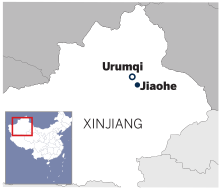
YU FEI/CHINA FEATURE
The ancient ruins of Jiaohe attract visitors in the Xinjiang Uygur autonomous region.

CHINA DAILY
The ancient city of Jiaohe had archaeologists stumped. Why were the older relics found near the Earth's surface, while more recent artifacts were buried far below? Yu Fei of China Features explores the city that went underground.
Jiaohe was not built by piling bricks from the ground-up it was carved into the earth.
A bird's-eye view of the ancient ruins shows a huge aircraft-carrier shape almost surrounded by water.
Dating back 2,500 years, Jiaohe was once a key city on the ancient Silk Road trading route. Today it lies 10 kilometers west of Turpan, in Northwest China's Xinjiang Uygur autonomous region, a silent witness to the cultural, economic and political exchanges between East and West.
"The ancients of Jiaohe were very clever to utilize the natural land-form to build the city's military defense system," says archaeology professor Chen Ling of Peking University.
The ancient city sits atop a large leaf-shaped peninsula, 1,650 meters long and 300 meters wide at its widest point, in the middle of a river. The steep cliffs, more than 30 meters high on all sides, acted as natural walls.
As with many other historical sites in Xinjiang, foreign explorers at the beginning of the 20th century took masses of precious relics from the ruins which now reside in museums in Germany, Britain and Japan.
UNESCO launched a protection project for Jiaohe in the 1990s, and organized more than 100 archaeologists to conduct a mass excavation. Although the city has reemerged from sand and dust, many puzzles remain unsolved.
Archeologist Xu Dongliang says that for along time during the excavation, archaeologists were stumped by the fact that the upper layers of many ruins of Jiaohe contained cave houses dating back 2,500 years, while the bottom layers revealed relics from the 13th century. Usually, the more recent relics are found closer to the surface.
After they completed the excavation, they came to the conclusion that the city was dug deeper and deeper by generations of Jiaohe residents over 2,000 years. The city had grown downward.
Some scholars believe that the city was first built by the people of the Cheshi Kingdom, who made it their capital about 2,000 years ago.
Over generations, it developed into a political and military center in the Turpan basin, expanding with streets, lanes, residential areas, temples, pagodas, markets, government offices and graveyards.
It was finally abandoned during an invasion by the Mongols led by Genghis Khan in the 13th century.
The city covers 430,000 square meters. Visitors today can still see the ruins of 1,339 homes, 106 cave-dwellings, five kilns, 52 temples, 316 wells and two markets, and imagine the hustle and bustle of its heyday.
Archeologists say that during its golden age in the 6th and 7th centuries, Jiaohe was much larger. But many buildings at the edges have collapsed as a result of flooding.
A central street, 350 meters long and 3 meters wide, runs from south to north. The tallest building has three floors. Most of the homes are half underground.
"Even the government office was built underground. Usually the government offices in a city are built high as a symbol of authority. But the government office in Jiaohe is underground, maybe for security reasons," Chen Ling says.
Archaeologists once tried to rebuild a large temple at the northern end of the central street, but they could never figure out how the roof would have looked. The temple had a central pillar, originally more than 10 meters tall, carved with various Buddha statues, while Buddhist pictures were painted on the walls of the corridor.
Japanese scholars surmised the hall of the temple had never had a roof because the ancients of Jiaohe in the 6th century lacked the mechanical expertise to cover such a large span.
However, dozens of bags of tiles were later found in the wells in front of the temple hall, proof that the temple once had a grand roof. But we can still only imagine what it looked like. None of the ruins has a roof today, so archaeologists are no closer to fully understanding their structure.
Archaeologists found 20 large tombs belonging to Cheshinobles to the north of the city. Sacrificial objects, horses, camels and slaves were unearthed from the tombs, but no remains of the tomb owners were found.
The tombs showed no signs of robbery, so archaeologists guess that when the Cheshi Kingdom was defeated, its people opened the tombs and fled with the remains of their ancestors.
More puzzling is a graveyard near the government office in the central area of the city, where more than 200 tombs of babies are neatly arranged.
They have no tombstones identifying the babies, how they died or why they were buried there.
On both sides of the streets stand high walls with no doors or windows. It feels like entering a maze of broken walls.
Invaders in ancient times would have had no place to hide when the defenders pummeled them with logs, stones and arrows.
Jiaohe was a city built for war, and it was also destroyed by war. A strategic point on the Silk Road, it saw countless battles.
The direct consequence of war was the assimilation of various ethnic groups. Nobody knows how many ethnic groups have lived there, but ancient documents record more than 10 ancient ethnic groups in the region, including Cheshi, Huns, Xianbei, Rouran, Gaoche, Turkics, Uygurs and Mongolians.
Bronze mirrors excavated from the tombs are in the style of ancient Greece, while the symmetrical lay-out of the city was obviously influenced by the culture of Central China.
The digging of a large number of wells was also introduced from Central China. Even today, they provide a flow of water that once nurtured people of different skin color, speaking different languages, wearing different dress.
We recommend:
